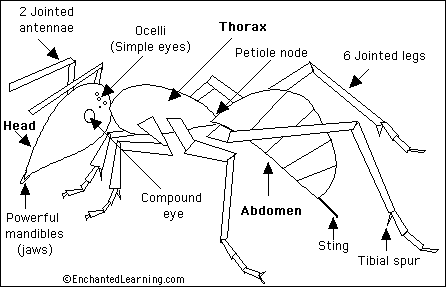Advertisement.
EnchantedLearning.com is a user-supported site.
As a bonus, site members have access to a banner-ad-free version of the site, with print-friendly pages.
Click here to learn more.
(Already a member? Click here.)

There are thousands of species of ants found all over the world and in just about every type of land environment. Many species are found in rain forests. The science of studying ants is called myrmecology.
These common social insects live in colonies (groups of related ants). Each colony consists of:
- Queen - The queen begins her life with wings, which she uses while mating. After mating with a male ant (or many males), she flies to her nesting area. She then loses her wings and spends her life laying eggs.
- Workers - Workers are the many sterile (non-reproducing), wingless female worker ants who are the daughters of the queen. These workers collect food and feed members of the colony, defend the colony, and enlarge the nest. Most of the ants in a colony are workers.
- Soldiers - Soldiers are large workers (sterile females) who defend the colony and often raid other colonies, capturing slaves.
.
- Males - Males are small ants that have wings. They fly from the colony to mate with a queen. They die soon afterwards.
Ants exhibit complex behavior; some ants build intricate nests, some are fierce warriors, some collect and store seeds (harvester ants), some capture slaves, and some farm fungi (leaf-cutter ants).
Anatomy: Ants, like all insects, have jointed legs, three body parts (the head, thorax and abdomen), a pair of antennae, and a hard exoskeleton. The exoskeleton is made up of a material that is very similar to our fingernails. Ants range in color from yellow to brown to red to black.
Some ants have a stinger and some can even inject poisonous acid from the stinger (the stinger is at the tip of the abdomen, the rear body segment). Ants can also bite using their jaws (mandibles). Ants range in size from about 0.08 inch (2 mm) to up to about 1 inch (25 mm) long.
Life Cycle: The life cycle of the ant consists of four stages: egg, larva, pupa, and adult. Fertilized eggs produce female ants (queens, workers, or soldiers); unfertilized eggs produce male ants.
- Egg: Ant eggs are oval shaped and tiny (they are on the order of 1 mm long, but the queen's egg is many times larger).
- Larva: The worm-like larvae have no eyes and no legs; they eat food regurgitated by adult ants. The larvae molt (shed their skin) many times as they increase in size.
- Pupa: After reaching a certain size, the larva spins a silk-like cocoon around itself (against a solid object, like the wall of the chamber) and pupates. During this time the body metamorphoses (changes) into its adult form.
- Adult: The pupa emerges as an adult. The entire life cycle usually lasts from 6 to 10 weeks. Some queens can live over 15 years, and some workers can live for up to 7 years.
Classification: Class Insecta (insects), Order Hymenoptera (ants and wasps - insects with a waist), Family Formicidae (over 8,000 species of ants).
Enchanted Learning Search
|
Search the Enchanted Learning website for:
|
Advertisement.
Advertisement.
Copyright ©1999-2018
EnchantedLearning.com ------ How to cite a web page

